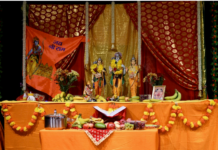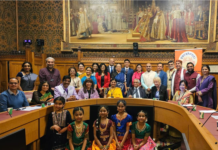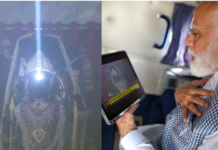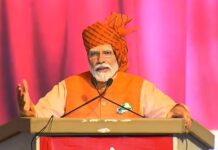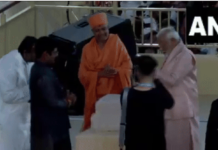As Lord Shiva is not complete without Shri Ram, the auspicious month of Shravan cannot be completed without mentioning history of Rameswaram, and no Hindu’s journey is complete without a pilgrimage to Rameswaram for the culmination of his quest for salvation hallowed by the epic ‘Ramayana’
Rameswaram, an island off the coast of the state of Tamil Nadu in mainland India, is home to one of the twelve Jyotirlingas.
After making friends with Sugriva ji through the mediation of Hanuman ji, Lord Ram sent Hanuman ji in search of Devi Sita, who was kidnapped by a demon called Ravan. Accordingly, Hanuman ji started his investigation and discovered Devi Sita in Sri Lanka and delivered the message of Shri Ram by giving her a ring of Lord Rama. He brought back her head ornament (chudamani) to his master Lord Ram.
Having learnt about the whereabouts of Sita Mata, Shri Ram decided to proceed to Sri Lanka himself to rescue his wife. He sat in meditation praying to The God of Ocean to make way. Annoyed with the delay, He took the bow and got ready to dart arrows against Samudra Raja. The king of ocean surrendered and showed the way for the construction of the bridge as a result.
Hanuman ji and his associates (Vanaraas) were engaged in the construction of the bridge by bringing big stones and even mountains. A small squirrel contributed its share in the construction by picking small particles of sand. Lord Rama’s heart was filled with gratitude witnessing this gesture, and he blessed the squirrel by touching its back, forming three strokes.
After the famous bridge Ram Setu was constructed, Shri Ram, Lakshman ji and the whole vaanar sena reached Sri Lanka to fight the demon and his army. Shri Ram chanted Aditya Hridaya Stotram (Lord Surya Mantras) suggested by Muni Agatsya, which resulted in victory against Ravana.
Having vanquished Ravan, Shri Ram crowned Vibhishan ji as the king of Sri Lanka. Later Shri Ram arrived at Rameshvaram with Mata Sita, brother Lakshman and Hanuman ji in a swan-shaped aircraft (Pushpak vimana).
In Rameshwaram, Shri Ram was praised by rishis, munis and other saints who were tortured by the demon however Shri Rama then asked them to suggest a way to get rid of the dosham (sin to kill) which he had incurred by killing Ravan. He was told that if he established and worshiped Shivalinga (symbol of Lord Shiva), he will be able to repent. According to the suggestion made by the saints, Shri Rama decided to perform Shiva Puja and requested Hanuman Ji to go to Kailasa Mountain and bring Shivalinga. Shri Ram and Laxman ji watched Sita Mata playfully making a Shivalinga out of sand.
Hanuman ji who had gone to Kailash to bring Shivalinga, had not yet returned after a long time. As it was the auspicious time for Pooja, Muni Agatsya told Shri Ram to perform Pooja to the Shivalinga made out of sand by Devi Sita. Sitting by the side of the Shivalinga which was made by Sita Mata, Shri Ram performed the ceremony according to the tradition in order to get rid of brahmatya dosham (sin to kill a Brahmin).
Lord Shiva with his better half Parvati Devi appeared in the sky and proclaimed that those who take bath in Dhanusha Kodi and pray to the Shivalinga would be purified from all the sins; they will be blessed with wisdom since Shri Rama has performed Pooja. The Shivalinga is called Ramalingam, the deity there is Sri Ramanathan Swami, and the place is called Rameshwaram.
Unable to meet Lord Shiva at Kailasha, Hanuman ji penanced, and obtained Shivalinga from Lord Shiva after explaining the purpose of his mission. Hanuman ji then flew to Rameshwaram, carrying the Shivalinga obtained from Lord Shiva. After reaching Rameshwaram, Hanuman ji found out that Shri Rama had already performed his puja to the sand Shivalinga and he apologised for the delay. He was extremely disappointed because the Shivalinga he brought was not worshiped by Shri Ram. Shri Ram had consoled him and asked Hanuman ji to try his best to remove the Shivalinga which was made of sand, and permitted him to install the Shivalinga he brought. Unable to remove the sand Shivalinga by his hands, Hanuman ji tried to pull it out with his mighty tale. Failing in all his attempts, he felt the divinity of the Shivalinga made out of sand by Sita Mata.
Shri Ram asked Hanumanji to place the Shivalinga he brought on the northern side of Ramalingam. He ordains that the people worship Ramalinga only after worshipping the Vishwa lingam, the Shivalinga brought by Hanuman ji from Kailasa. Even today the same procedure is followed. The temple comprises 22 wells where the taste of the water of each well is different. One has to take bath in all these 22 wells to complete the ritual of the holy land. The number 22 indicates the 22 arrows in Rama’s quiver.
 BY Priya Lekha
BY Priya Lekha
(Sharawan month holds a great religious significance among Hindus. This month is considered to be one of the most auspicious months in the year. During Sharawan month, Lord Shiva and Goddess Parvati is worshipped with great devotion and dedication.)

Readers like you, make ESHADOOT work possible. We need your support to deliver quality and positive news about India and Indian diaspora - and to keep it open for everyone. Your support is essential to continue our efforts. Every contribution, however big or small, is so valuable for our future.


